
Archives

Archive for March, 2010 | |
Studio Custom, LeftyPosted on March 5, 2010
We recently seem to be getting our share of left handed guitars. The first step in building any Hamer is selecting the wood. While it's always a painstaking process, sometimes we have to pay even more attention than others. That's especially true with this very special Studio Custom. Our customer actually sent us a photo of the Ultimate grade quilted maple he wants us to match for the guitar's top. The Talladega in the photo was displayed at last year's NAMM show. | 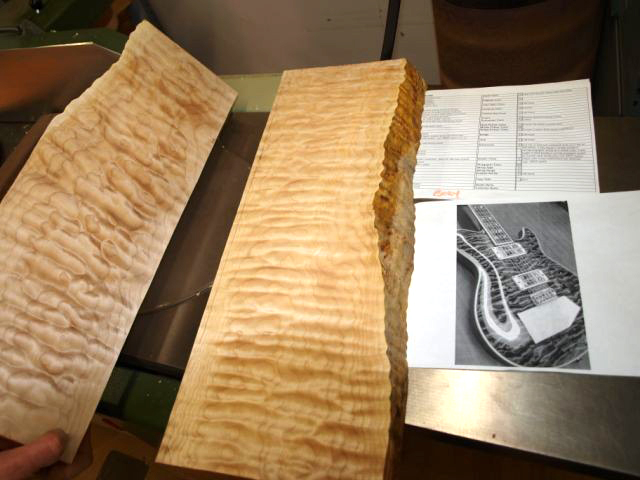
|
| 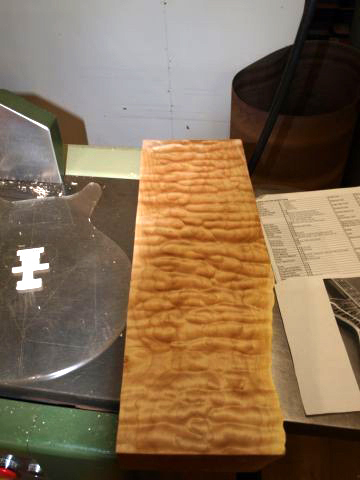 |
Standard with Kahler TremoloMarch 11, 2010
Here's a hard rocking custom Standard that we recently completed. We painted it with an off white face with black back and sides. How about that maple fingerboard? We fitted the Standard with a Kahler tremolo but without a locking nut. Instead, the Schaller clamp machine heads retain stable tuning. With an EMG '81 and '85. this guitar is a blast from Hamer's 80s past. | 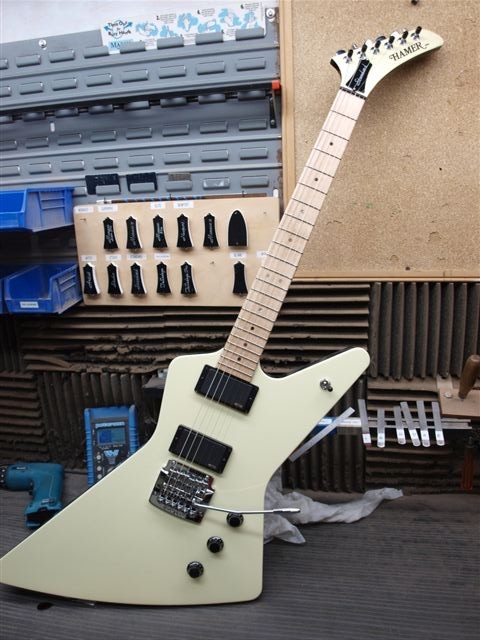
|
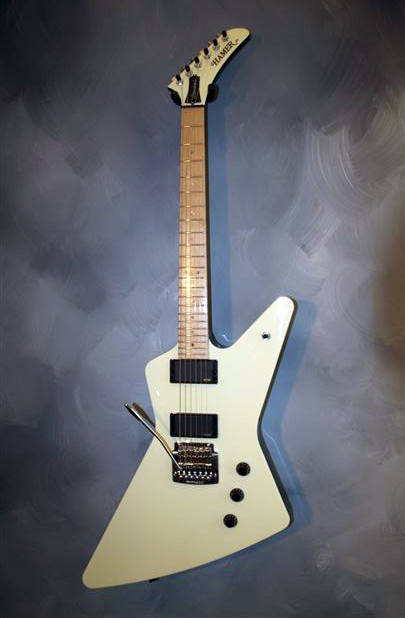 | 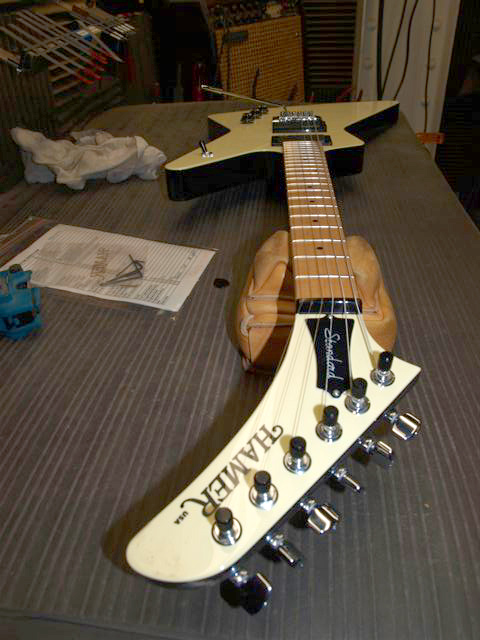 |
Vector IIIMarch 15, 2010We last visited the Vector III when we were matching the mahogany back cavity cover plate to the solid mahogany body and the flame maple truss rod cover to the peghead overlay. As you can see, we've made considerable progress since then. Here we see the body bound with inlaid mother of pearl purfling. It's now ready for the neck to be fit. (see Jol Dantzig Blog: Janurary 2010) | 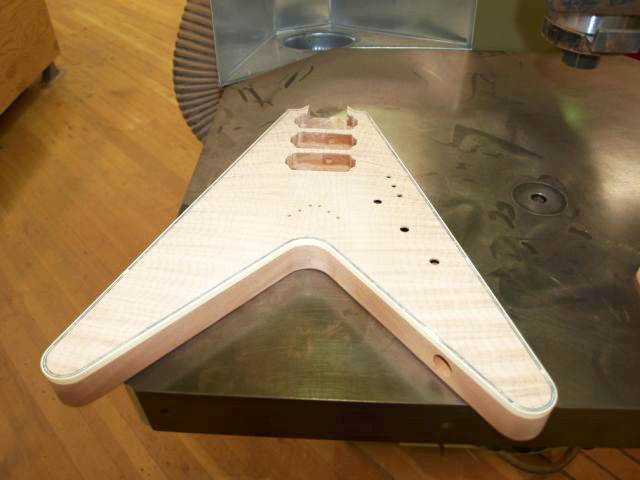
|
The neck, with its matching mother of pearl purfling, will soon be mated to the body. Dig the coloration of the Brazilian fingerboard. Brazilian is now a protected species. Unfortunately, it was over logged for years and has been severely depleted. Our Brazilian rosewood comes from two sources. The first source is from wood that was harvested years ago and used in building construction. Believe it or not, there are beams in South America made from Brazilian rosewood. A friend of ours who hails from Brazil deconstructs the Brazilian rosewood structures and then legally exports the wood to the U.S. The second source is "stump wood". Previously when cutting trees, loggers left the stumps standing. The stumps are generally about three to four feet high, the height from the ground of where the tree was sawn. We take pride in that we are able to continue to offer Brazilian rosewood while not impacting the standing forests. | 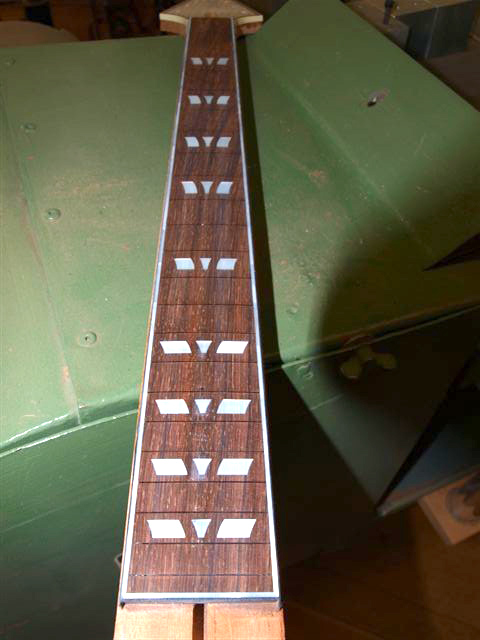
|
The neck is joined to the body. Dave then carves, or blends, the neck heel for a seamless transition between the body and neck. | 
|
Here's a close up of Dave using a hand file to blend the heel. You'll notice that the mahogany coloration is lighter in the area that he is working. That's because, prior to blending, we fill the neck and body with a specially formulated paste wood filler. The filler is used to fill the pores of the wood to ensure for flat surface onto which we spray. Properly filled wood impedes sinking of the lacquer into the wood. This, in turn, translates into a flat, even, mirror-like finish. | 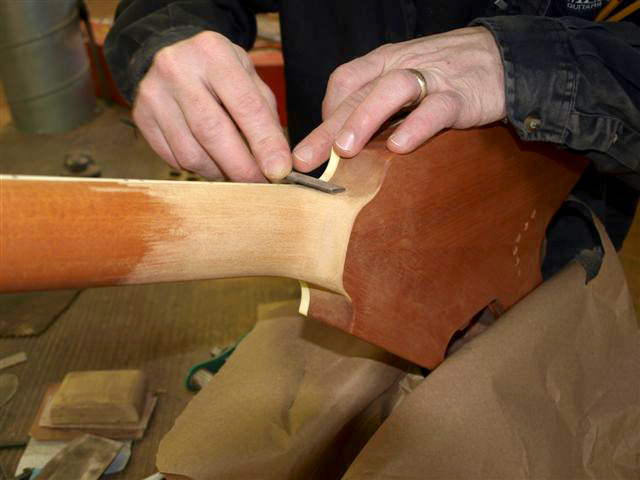
|
The Vector has made its way to the spray booth. If you think that it's beautiful in it natural state, wait until we spray some finish on it. Once we have sprayed color over the neck joint, Dave's blending work is really highlighted.
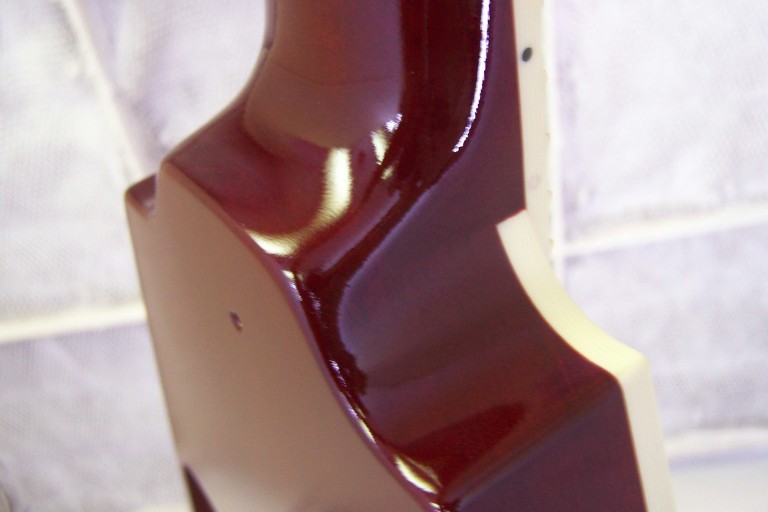
After it has been prepped and taped, Gary sprays our signature '59 burst on the Vector III. Sunburst finish has always been a trademark for Hamer - so much so that we named a guitar after it! As many of you know, Gary's sunbursting sets the industry standard. Here's a little closer look at Gary working his craft. The flamed maple really comes to life with the burst. | 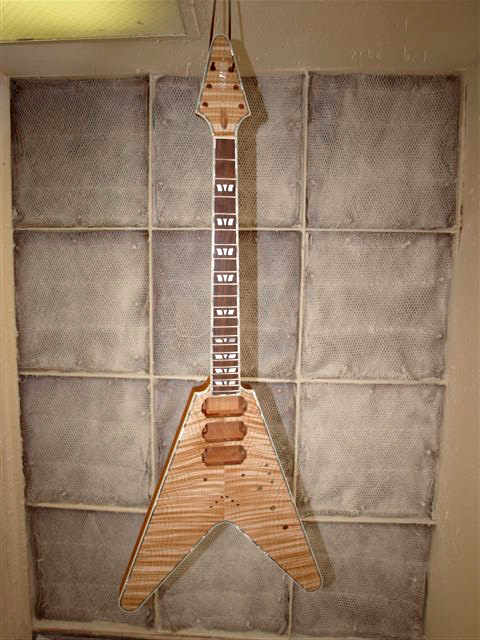
|
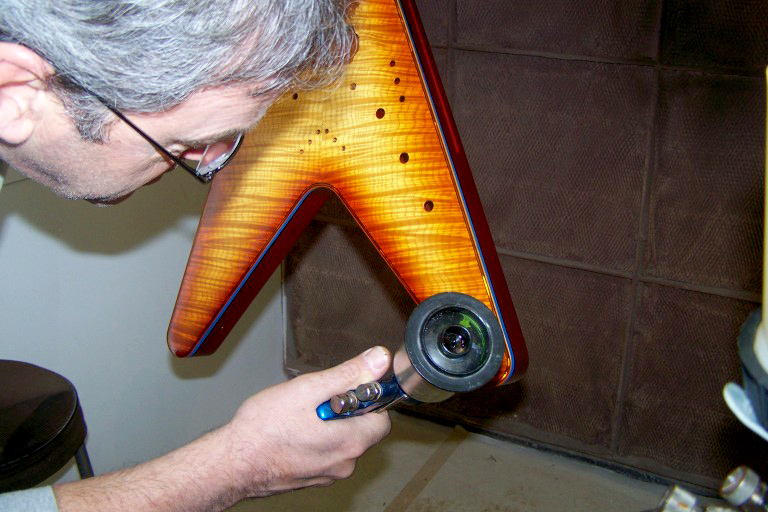
|
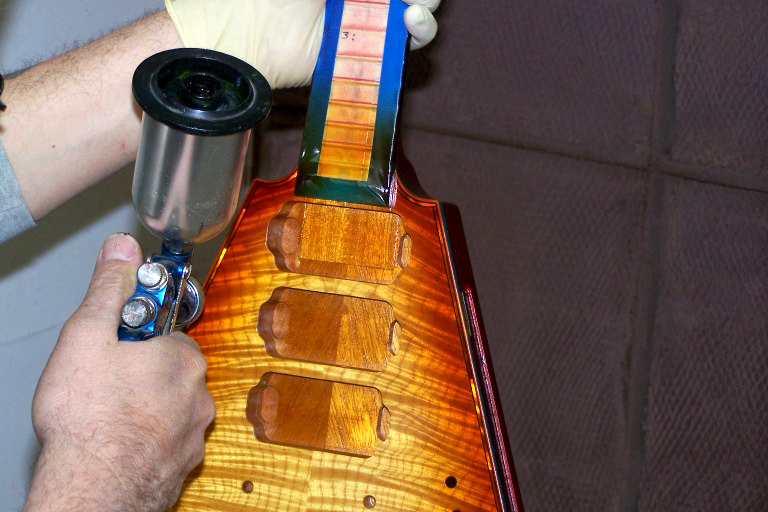
|
Back in BlackMarch 19, 2010 | |
From the onset Hamer has listened to guitarists' input regarding our instruments. We have always recognized that our team does not stop at the shop door. Rather, musicians, music dealers, distributors, the music press and many others are a part of what comprises Hamer Guitars. Years ago, when we were still working out of our Arlington Heights, Illinois shop, our Japanese distributor came to us with a request that appeared to be an oxymoron. They asked us for a guitar in black transparent. This request pre-dated other guitar manufacturers offering such a color. As many of you may be aware, rather than staining the wood, Hamer normally sprays color over clear coats of lacquer. We feel that this results in a cleaner finish. Though we tried mightily, we could not thin out the black sufficiently so that we could spray a true black transparent over a figured maple top. As a result, we decided to start experimenting with stains. However we did not like the "dirty" look that resulted from staining maple. We continued to work on it, until we finally developed a three-step staining process whereby we stain the wood, sand it down, stain it again with a diluted stain, sand it with a finer grit, stain it a third time and finish with steel wool. We then spray clear coats over the stained top. It's an incredibly labor intensive process but we've found that it results is a black transparent that we can be proud of. We previously featured a Standard 12-String Bass sporting a black transparent finish. This Artist may be somewhat less over the top but it's a great example of our execution of this black transparent on a 6-String. | 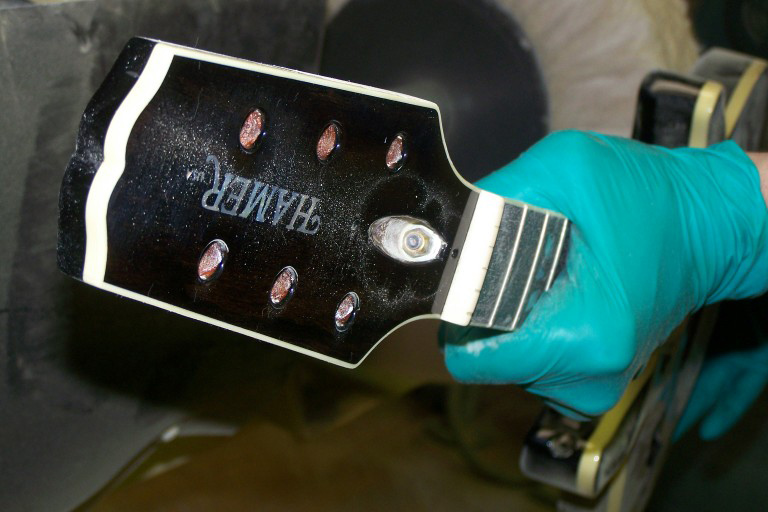 An ebony headstock face with a genuine mother of pearl hand inlaid logo beautifully compliments a black transparent finish. 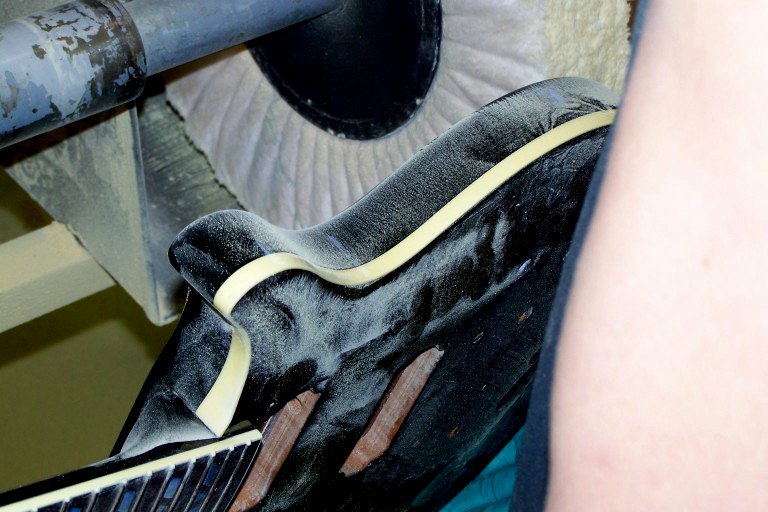 Hamer guitars have always been hand buffed and polished. Here Todd is buffing out the back of this Artist Custom. |
A lot of guitar companies these days claim that their guitars are made by musicians for musicians. We mean it. Many of our luthiers are also players. | 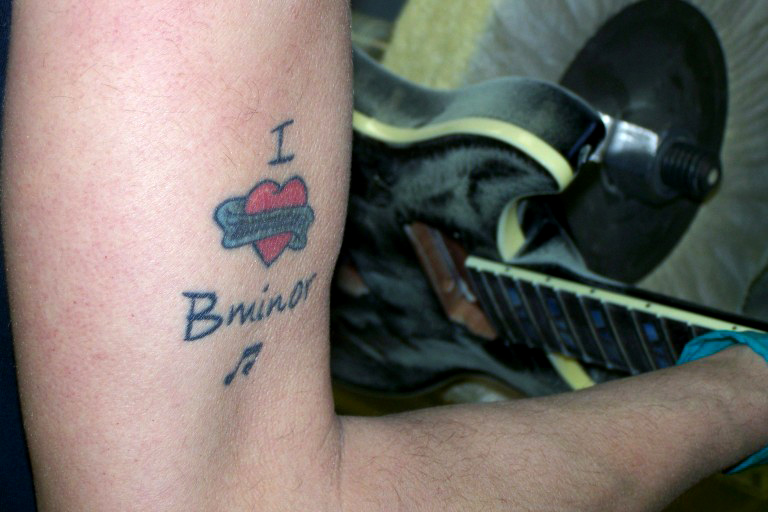 |
We shield our electronics cavities with a nickel based paint and hand wire all Hamers. If you have been following Hamer for some time, you're probably aware that we use oxygen free copper wire when wiring our electronics. We feel that the interior of the guitar should display the same level of craftsmanship as the exterior. You can see the plexiglass shield that we place over the back of the guitar when soldering so that no harm can come to the guitar itself. After we are done wiring the guitar, the electronics cavity is covered with an anodized aluminum backplate. | 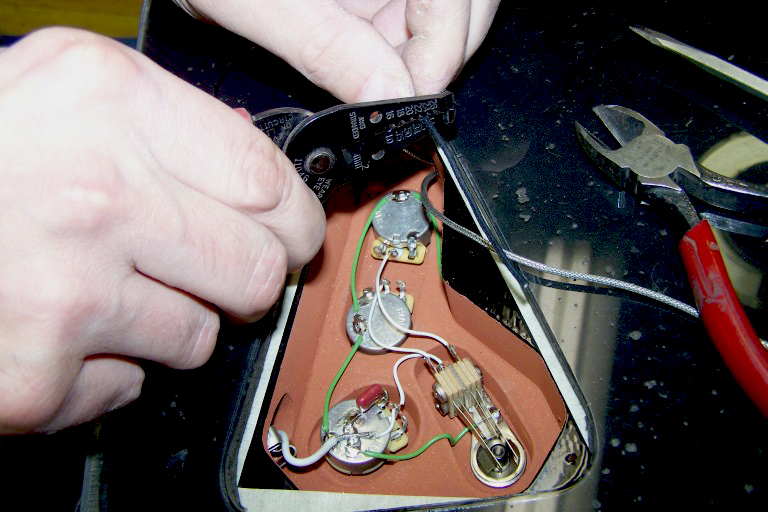 |
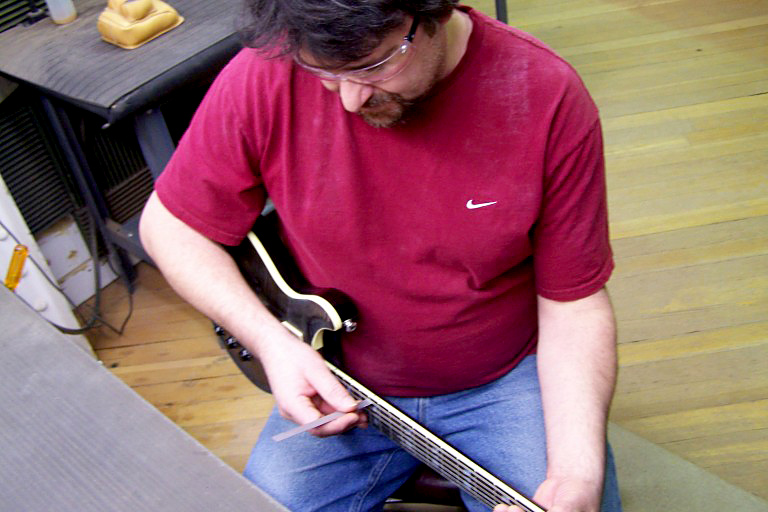 Chris in the set up room, readying to put the Artist through its paces. Prior to an extensive play test, we cut the nut, measure the string action and check the truss rod one last time. | 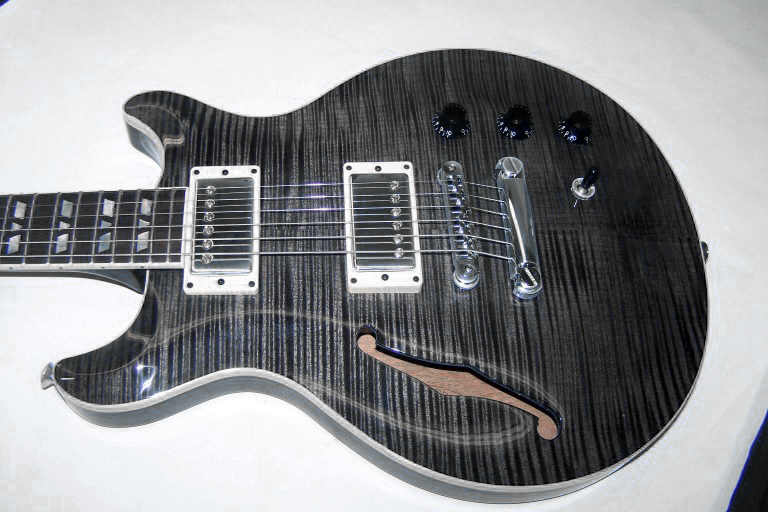 The end result is stunning. We're still happy that we got that original request for transparent black. |
Freedom! (Richie Havens Pays A Visit)March 24, 2010 | |
It's always nice when one of our endorsing artists visits the shop. As many of you are aware, in April 1997 we moved Hamer Guitars from our Arlington Heights, Illinois facility to New Hartford, Connecticut. New Hartford had previously only housed Ovation guitars. A couple of years ago we moved Guild guitars from Tacoma, Washington to New Hartford. As a result, New Hartford now houses three distinct boutique guitar manufacturers, all in their separate and unique space. This means that while we've had visits from Hamer artists such as Keb Mo, Rick Nielsen and Jon Herington, we have also had Ovation artists like Al DiMeola and Kaki King come by. Last week we were happy to play host to long time Guild endorsing artist Richie Havens. Richie spent the afternoon touring the facility, stopping and talking with many of our people along the way. Richie is a spiritual and approachable human being with a warm smile. He brought joy to everyone that he met. To this day he continues to preach peace and sing out against injustice. At the end of the tour we asked Richie if he would be willing to play a few songs for the crew. He gladly agreed to and we pulled together the entire shop (Hamer, Ovation and Guild) for a straight acoustic set: no microphones, amps or anything, just Richie and his guitar. Richie started with Here Comes the Sun, continued with Maggie's Farm and concluded with Freedom. It was a truly special moment. | 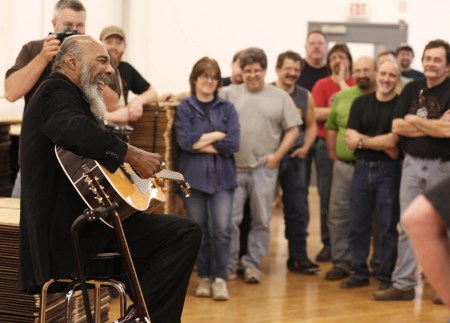 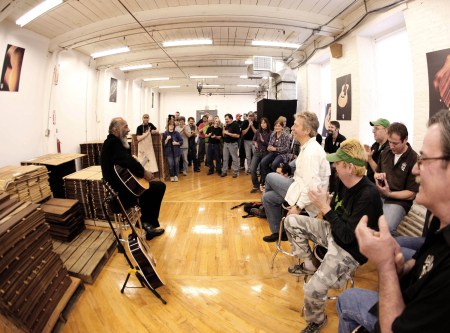 |
If you're not aware, Richie has a unique playing style. In addition to an extremely aggressive attack (he has a pickguard on both the bass and treble sides of the strings), he tunes his guitar to open D. He then uses his thumb to bar up and down the neck, working his thumb almost like a capo. It's wild and it works. Richie developed this playing style when he first took up guitar. He was singing along one night while watching blues artist Fred Neil play in Brooklyn. Fred told him that he should learn the song on the guitar. Richie went home and asked his Doo-Wop band members to sing the notes of a D chord. He tuned the guitar to their voices and found that he could play up and down the fingerboard with the tuning. He's stuck with it ever since. Though he's not a Hamer endorser (yet), we thought that you'd like to hear the story and see a couple of photos. | |
| Previous Month: Jol Dantzig Blog | Next Month |